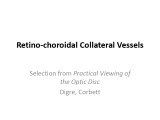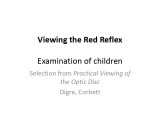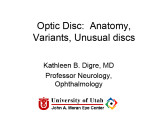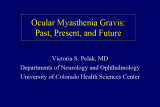Collection of materials relating to neuro-ophthalmology as part of the Neuro-Ophthalmology Virtual Education Library.
NOVEL: https://novel.utah.edu/
TO
- NOVEL717
| Title | Creator | Description | Subject | ||
|---|---|---|---|---|---|
| 251 |
 |
Parasellar Meningioma | Shirley H. Wray, MD, PhD, FRCP | This patient is a 58 year old woman from Peru who, in 1975, developed intermittent headaches and right retro-orbital eye pain. She was seen by several ophthalmologists in South America who were unable to make a diagnosis. In March 1977 she awoke one morning with vertical diplopia most marked on look... | Ptosis; Third Nerve Palsy; Aberrant Reinnervation of the Third Nerve; Oculomotor Nerve; Parasellar Meningioma; Cavernous Sinus Syndrome; Unilateral Oculomotor Third Nerve Palsy; Unilateral Third Nerve Palsy |
| 252 |
 |
Parkinsons Disease | Shirley H. Wray, MD, PhD, FRCP | See also: http://content.lib.utah.edu/cdm/ref/collection/ehsl-shw/id/298 and http://content.lib.utah.edu/cdm/ref/collection/ehsl-shw/id/93 | Blepharoclonus; Convergence Insufficiency; Slow Hypometric Horizontal Saccades; Saccadic Breakdown of Smooth Pursuit; Parkinson's Disease- Dopamine deficiency; Basal Ganglia; Blepharoclonus; Convergence Insufficiency; Slow Hypometric Saccades; Saccadic Breakdown of Smooth Pursuit; Parkinson's Disea... |
| 253 |
 |
Neuroblastoma | Shirley H. Wray, MD, PhD, FRCP | The patient is Case 27-1995 Case Records of the Massachusetts General Hospital (New Eng. J Medicine 1995, 333:579-586). The discusser was Dr. Elizabeth Engle, Associate Professor of Neurology, Harvard Medical School. The baby girl was born after a 30 week gestation, with a birth weight of 1.25 kg. T... | Downbeat Nystagmus; Paraneoplastic Opsoclonus; Neuroblastoma; Primary Position Downbeat Nystagmus; Ataxia; Paraneoplastic Downbeat Nystagmus |
| 254 |
 |
Septo-Optic Dysplasia | Kathleen B. Digre, MD; James J. Corbett, MD | Slideshow describing the condition. | Septo-optic Dysplasia |
| 255 |
 |
Retino-choroidal Collateral Vessels | Kathleen B. Digre, MD; James J. Corbett, MD | Slideshow describing condition. | Collateral Vessels |
| 256 |
 |
Viewing the Red Reflex | Kathleen B. Digre, MD; James J. Corbett, MD | Slideshow describing eye examination of children. | Eye Examination |
| 257 |
 |
Photophobia for Patients - Large Print | Kathleen B. Digre, MD | The symptoms of light sensitivity are: an uncomfortable sense of brightness, squinting, frequent blinking, and redness of the eye (especially if the eye is dry). Involuntary eye closure and excessive blinking is seen with blepharospasm. Individuals will tend to seclude themselves in darkness. | Photophobia |
| 258 |
 |
Papilledema 2013 | Kathleen B. Digre, MD | Objectives: What types of disc findings can be confused for papilledema List the features of true disc swelling Describe the tests you would order to evaluate and w/u papilledema List differential diagnosis of papilledema Describe possible treatments for papilledema (medical and surgical) | Papilledema |
| 259 |
 |
Optic Disc Anatomy, Variants, and Usual Discs | Kathleen B. Digre, MD | Examination of optic disc, disc anatomy, disc variation. | Optic Disc; Normal Disc Anatomy |
| 260 |
 |
Retinal Detachment: The Basics | Arnav Gupta, BHSc; Rahul Sharma, MD, MPH | A presentation describing retinal detachment. | Retinal Detachment |
| 261 |
 |
Retinal Exudate: The Basics | Arnav Gupta, BHSc; Rahul Sharma, MD, MPH | A presentation describing retinal exudate. | Retinal Exudate |
| 262 |
 |
Retinal Hemorrhage: The Basics | Arnav Gupta, BHSc; Rahul Sharma, MD, MPH | A presentation describing retinal hemorrhage. | Retinal Hemorrhage |
| 263 |
 |
Retinal Causes of a Neurologic-Type Visual Field Defect | Omar Ozgur, MD; Rudrani Banik, MD | Power point of case presentation of 47 year old female with history of breast cancer with new onset temporal visual field defect and photopsias. Differential diagnosis of homonymous hemianopia discussed; retinal causes of neurologic-type visual field defects reviewed including: white dot syndrome (m... | Homonymous Hemianopia; Neurologic Visual Field Defect; Temporal Visual Field Defect; White Dot Syndrome; Multiple Evanescent White Dot Syndrome (MEWDS); Cancer-Associated Retinopathy; Tamoxifen Retinopathy; Autoimmune Retinopathy |
| 264 |
 |
Homonymous Hemianopia (Traditional Chinese) | NANOS | This refers to an absence of vision towards one side of the visual world in each eye. The damage that caused this problem is in the brain and not in the eyes. | Homonymous Hemianopia; Patient Brochure |
| 265 |
 |
Thyroid Eye Disease (Simplified Chinese) | NANOS | This is an autoimmune condition where your body's immune system is producing factors that stimulate enlargement of the muscles that move the eye. | Thyroid Eye Disease; Thyroid Orbitopathy; Patient Brochure |
| 266 |
 |
Hemifacial Spasm (Simplified Chinese) | NANOS | Involuntary contractions, called "spasms," of the muscles on one side of the face. The affected side of the face seems to "scrunch up" while the other side of the face remains normal. | Hemifacial Spasm; Patient Brochure |
| 267 |
 |
Anterior Ischemic Optic Neuropathy AION (Russian) | NANOS | Loss of blood supply to the optic nerve results in diminished visual acuity. | Anterior Ischemic Optic Neuropathy; Patient Brochure |
| 268 |
 |
Anterior Ischemic Optic Neuropathy (Traditional Chinese) | NANOS | Loss of blood supply to the optic nerve results in diminished visual acuity. | Anterior Ischemic Optic Neuropathy; Patient Brochure |
| 269 |
 |
Pseudotumor Cerebri (Russian) | NANOS | This is a condition in which high pressure inside your head can cause problems with vision and headache. | Pseudotumor Cerebri; Patient Brochure |
| 270 |
 |
Migraine (Russian) | NANOS | Headache on one or both sides of the brain, and may include symptoms of nausea, vomiting, and sensitivity to light. | Migraine; Patient Brochure |
| 271 |
 |
Anisocoria (Traditional Chinese) | NANOS | The pupil in the right eye and left eye are not the same size. | Anisocoria; Patient Brochure |
| 272 |
 |
Anisocoria (Russian) | NANOS | The pupil in the right eye and left eye are not the same size. | Anisocoria; Patient Brochure |
| 273 |
 |
Brain MRI in Multiple Sclerosis | Anne G. Osborn, MD | Slideshow describing condition. | Abducting Nystagmus; Bilateral Internuclear Ophthalmoplegia; Botulinum Toxin Therapy; Gaze Evoked Downbeat Nystagmus; Horizontal Pendular Nystagmus; Horizontal Saccadic Dysmetria; Lid Nystagmus; Multiple Sclerosis; Normal Convergence; Oscillopsia; Pendular Horizontal Oscillations; Saccadic Dysmetri... |
| 274 |
 |
Ocular Myasthenia Gravis: Past, Present, Future | Victoria S. Pelak, MD | Slideshow describing condition. | Bilateral Myasthenia Gravis; Bilateral Ptosis; Bilateral Weakness of Adduction; Decompensated Phoria; External Ophthalmoplegia; Familial Myasthenia Gravis; Myasthenic Lid Twitch; Ocular Myasthenia Gravis; Positive Tensilon Test; Pseudo-internuclear Ophthalmoplegia; Tensilon Test; Unilateral Myasthen... |
| 275 |
 |
Cavernous Sinus Meningioma | Shirley H. Wray, MD, PhD, FRCP | Slideshow describing condition. | Abducting Nystagmus; Cavernous Angioma; Convergence Normal; Facial Palsy; Facial Weakness; Fisher's One-and-a-Half Syndrome; Pendular Vertical Oscillations; Pontine Hemorrhage; Unilateral Gaze Palsy Hemorrhage; Unilateral Horizontal Gaze Palsy; Unilateral Internuclear Ophthalmoplegia; Upbeat Nystag... |
